T:-)M's Night Shift
T:-)M's Walkin' from Rushy Mountain to Botany Bay
Since 1998 Maurice O'Keeffe of Tralee has travelled the
highways and byways of the south and west of Ireland,
gathering and preserving the unique oral tradition of
the counties of Kerry, Cork, Clare, Limerick and
Galway. 330 individual recordings of hour long
duration, in CD format, have now been produced
featuring the folklorists, storytellers, musicians,
local historians and archaeologists of the counties
(-> FW#27).
The Ancient Barony of Duhallow - Living Voices, produced by Maurice's wife
Jane, is the first in a series of five books about the
Irish Life and Lore
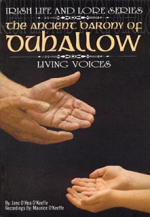 recordings in selected areas. To come are West Limerick, Kerry, Clare and Galway,
45 CDs cover the area of the ancient barony of Duhallow
which straddles along the Cork/Kerry border.
The area includes the sites of the Battle of Knockbrack in 1651 and
Knocknanuss in 1647 during the Cromwellian Wars;
the Scottish warrior Alistair McDonald was killed during the latter,
commemorated in "Allistrum's March" (->
FW#24).
In the west of Duhallow lies Sliabh Luachra with its unique tradition of music and poetry.
recordings in selected areas. To come are West Limerick, Kerry, Clare and Galway,
45 CDs cover the area of the ancient barony of Duhallow
which straddles along the Cork/Kerry border.
The area includes the sites of the Battle of Knockbrack in 1651 and
Knocknanuss in 1647 during the Cromwellian Wars;
the Scottish warrior Alistair McDonald was killed during the latter,
commemorated in "Allistrum's March" (->
FW#24).
In the west of Duhallow lies Sliabh Luachra with its unique tradition of music and poetry.
"Living Voices" summarises each recording briefly with 1-2 pages and lots of
ravishing pictures: Julia Mary Murphy remembers her late husband, fiddler
Denis Murphy.
There is namesake and fiddler Maurice O'Keeffe of Kiskeam, where
the Maurice O'Keeffe Festival is held annually in April, including
a discusson that relates to the future of the pure traditional music as opposed
to the improvisation allowed in the modern style.
There is melodeon player John Sheahan of Shrone talking about the
pilgrimage to the once pagan shrine at the foot of the Paps Mountains;
on 1st May a carnival atmosphere was created by dancers and musicians,
including the blind fiddler Tom Billy Murphy.
Maurice was present at
Johnny O'Leary's
80th birthday celebration in Dan O'Connell's pub in Knocknagree
(alongside Donal Hickey who wrote "Stone Mad for Music" about
the music, singing, dance, poetry and spirit of Sliabh Luachra):
Renowned and well loved musician, Johnny O'Leary, reached 80 years of age in May 2003.
He was born into the heart of Sliabh Luachra at Maulykevaune in 1923. I travelled to
Dan O'Connell's pub in Knocknagree to join in the celebrations and how lucky I was to
be there as it was a night of wonderful music and conversation, interspersed with yarns
and jokes - a night never to be forgotten. Thirty five musicians from Kerry, Cork, Clare,
Limerick and beyond, came together for the occasion, and the music lifted the rafters
and the hearts. Jim O'Brien from Killarney had composed a song in honour of Johnny. The
local pipe band, under pipemajor Con Houlihan, paid tribute to Johnny's fame, along with
many fiddlers, accordion players, flautists, uileann pipers and spoon players, and the
music lasted long into this wonderful night of tribute to Johnny O'Leary, master musician,
master storyteller and wonderful champion of the music of his native place.
Johnny described to me his emotional feelings of pride and gratitude on this memorable
occasion and then took up his beloved accordion and played a few reels for the company.
Before I knew it, set dancers took to the floor and a session got well under way. The
music that I heard on that memorable night was magical - music from the heart and soul
of a people - music to lift the spirits and banish all of life's cares.
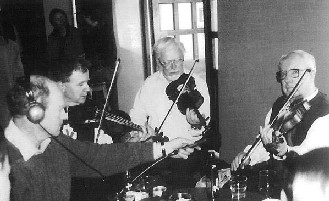
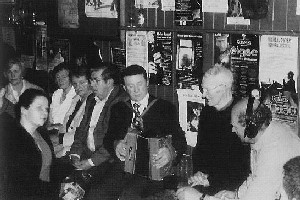
One Maurice O'Keeffe recording another;
Johnny O'Leary at his 80th birthday celebrations, ft. Mick & Michelle Mulcahy.
The McCarthy clan settled in the Duhallow area in the 13th century, the McCarthy Castle at
Drishane displaying its coat of arms and their motto: To the strong and faithful
nothing is difficult. Pete McCarthy, an
Englishman with Irish ancestry, must have had
the same spirit when he was looking for all the McCarthys
in Ireland and abroad. The Road to McCarthy was my last year's holiday
reading, sequel to this successful "McCarthy's Bar." Pete made his acquaintance
with Irish music:
In the 1980s a London Irish band called the Pogues
reinvented Irish music, playing the traditional songs with punk frenzy and writing a
clutch of classic new ones in the bargain. Their singer and songwriter
Shane MacGowan
[-> FW#22]
was eventually sacked, amid tales of alcoholic excess and worse. He's due to play in
a Greenwich Village dance-hall tonight. MacGowan seems determined to live out the role
of terminally alcoholic Irish visionary in which he has cast himself, so there is
always the added frisson these days that if he does turn up it may be the final show.
As we splash through the streets in search of the venue, I picture Shane in his
dressing-room drinking pints of Martini while a priest gives him the last rites and
the sound engineer gets ready to tape the show - Live Death, The Album.
He's clutching a glass and wearing a traditional black Irish drinking suit, which is like
an ordinary black suit, only with more stains. The sprung dance floor is bouncing up and
down our feet. Plastic glasses arc through the air, the cascading beer dramaticaly lit by
the stage light as it soaks the audience in what is almost certainly a witty post-modern
reference to St Patrick baptising the Irish. Teenagers, ageing punks and superannuated
Greenwich Village hippies are careering into each other with wild abandon as the band
crank through their repertoire of high-octane laments.
Tonight - Shane MacGowan discusses his songwriting. Someone in the audience asked
what's the most recent song he's written, and he grinned before launching into an a
capella rendition of a ballad about being buggered by a bishop, which had the whole
place in stitches. He was most passionate when talking about Irish culture, Irish music
and the things he hates about England, despite of the fact that a life lived mostly
in London has left him with that city's accent. With drink and fag constantly in hand,
he seemed almost consciously to be casting himself as the new
Brendan Behan,
a rough-and-ready man of the people gifted with poetic brilliance. In an era of boy bands
and stadium rockers he makes a convincing keeper of the Irish tradition. Shane gets up
from his stool, the whole room bursts into a round of applause. Some of them are standing.
It's extraordinary. They're clapping him for being him, for existing, for still being
alive. If it's a populist hero he wants to be, then he's got it. Happiness, though, might
be another thing entirely.
Shane was an important chain-link in the development of traditional Irish music into
contemporary Irish music. One of its key figures, however, when the roots were buried
deeply in the mid 20th century, was
Seán Ó Riada.
Imagine no Pogues (might be okay for you), but imagine no Chieftains!
and that's for sure, and you can argue furthermore,
imagine no Planxty or Bothy Band, no Moving Hearts or Riverdance!
Seán Ó Riada - His Life and Work is the first biography of the man
who spearheaded the revival of Irish traditional music. Its author is
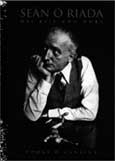 Tomás Ó Canainn,
singer and uilleann piper of 1970s group Na Filí. Tomás lectured in
engineering at University College Cork (UCC) when Sean died in 1971 and succeeded him in
the Music department. Now he looks behind the mask of Riada.
Tomás Ó Canainn,
singer and uilleann piper of 1970s group Na Filí. Tomás lectured in
engineering at University College Cork (UCC) when Sean died in 1971 and succeeded him in
the Music department. Now he looks behind the mask of Riada.
Seán Ó Riada was born in 1931, his father was a policeman in Adare. He
could play the violin and often had a tune with the fiddler Patrick Kelly (->
FW#27).
Sean's mother could play a tune on almost any instrument. She always regretted that
she never had any professional training and thus had Seán porperly trained.
Seán entered UCC in 1948, being Professor
Alois Fleischmann's only student.
(Fleischmann, born in Munich, raised and educated in Cork, started
a student project in the 1950s on the collections of traditional music;
"Sources of Irish Traditional Music" appeared in print posthum in 1999,
two mighty volumes including a comprehensive catalogue of tunes from about 1583 to 1855.)
At the time Seán inhabited two worlds - the academic life and the
world of jazz and dance music, making some bucks by playing piano in a dance band.
When Gael Linn
decided to make their first long-playing record, he was asked to be producer. It
contained arrangements of Irish airs played by the Radio Éireann Light Orchestra.
He was also recommended as the music composer of the film Mise Éire in 1959,
the main theme being the traditional air "Róisín Dubh". Eventually he became
Director of Music at Dublin's Abbey Theatre.
Perhaps his most memorable work for the Abbey Theatre was the music he composed for
Bryan McMahon's "Song of the Anvil". The play called for Wren Boys on stage,
Peadar Lamb, on bodhrán, being one of them. Seán and Bryan decided that the
normal Abbey Theatre musicians would not be suitable for the new drama, which would
require something more traditional. They brought together a new traditional group
that included Paddy Moloney,
Éamonn de Buitléar,
Michael Tubridy,
Seán Potts,
Martin Fay
and Ronnie McShane.
When "Song of the Anvil" had finished its run in the theatre, the band stayed
together and continued to practise in Seán's house. Seán wanted a group that would
bring the arts together, so that music, poetry, song and dance would intermingle
at a single session.
The new group, Ceoltóirí Cualann,
made its debut in concert in 1961.
Seán himself played harpsichord so that he could direct affairs from his position
at the keyboard. The harpsichord was his substitute for the Irish harp, because
he attacked the use of the piano to accompany traditional music:
This is a scar, a blight, on the face of Irish music. The reason for it is easy to see.
It is a truism to say that we suffer in this country from a national inferiority complex.
To combat it we have developed a number of tricks which we hope will fool others into
thinking we are better than we are. The piano is such a trick. It has become a
symbol of respectability. The house that has a piano loks down on the house that hasn't.
Irish traditional music well played is sufficient unto itself; a piano accompaniment
detracts from and confuses it. All the finesse of the fiddle player, all the subtlety,
delicate touches and fine pointe are clouded over and coarsened.
Seán always was a forthright and uncompromising man:
Most accordion players are so hampered by their choice of instrument as to be unable to
produce anything but a faint wheezy imitation of Irish music. And unfortunatly this
instrument, designed by foreigners for the use of peasants with neither the time,
inclination nor application for a worthier instrument is gaining vast popularity. The
reason for this is mainly laziness. We would all like to be musicians, but we don't
want to take the trouble.
About céilí bands:
The most important principles of traditional music - the whole idea of variation, the
whole idea of the personal utterance - are abandoned. Instead, everyone takes hold of a
tune and belts away at it without stopping. The result is a rhythmic but meaningless
noise with as much relation to music as the buzzing if a bluebottle in an upturned jamjar.
Seán's idea was group playing with variety in the performance:
It must not flog away all the time, with all instruments going at once, like present-day
céilí bands. Ideally, it would begin by stating the basic skeleton of the
tune to be played; this would then be ornamented an dvaried by solo instruments, or by
small groups of solo instruments. The more variation the better, so long as it has its
roots in the tradition, and serves to extend that tradition rather than destroy it by
running counter to it.
The uilleann pipes, the flute and the whistle would make up a reasonable wind section.
Fiddles there should be and also accordions to help fill out the passages where the
whole band is playing. As for drums, the modern notion of using a jazz drum-kit is
entirely out of tune with Irish music. Their sound is coarse and without subtlety. But
I think that our native drum, the bodhrán would be very suitable. I think also
that a harp played in the traditional fashion would lend an edge, and occasional
harmony, to this ideal band.
Paddy Moloney went on to form The Chieftains
to fulfill much of Seán's visions and eventually incorporated
a harp player in the person of
Derek Bell
(-> FW#24).
When Seán Ó Riada died in 1971, traditional Irish music was well on its way.
I'm not that sure what Seán would think of the crwth. The ... what?
Now folks, the crwth (pronounced crooth), is
a six-stringed medieval bowed lyre. Not unlike the Irish harp, the crwth in Wales
was an instrument played at the courts of the Welsh aristocracy. At one time, it was
widely used in Europe. However, crwth playing couldn't compete to the fiddle and their
modern repertoire of country dance tunes and it ceased to be played.
During the later sixteenth and seventeenth centuries Welsh music had undergone a
substantial period of modernisation. A native string repertoire associated with
earlier instruments such as the crwth and bray harp, as recorded in the c. 1613
manuscript of Robert ap Huw [-> FW#18], had survived precariously up to that point
under an antiquated system of patronage. But the Welsh gentry were losing interest
in the old instruments and their unfashionable music.
Contact with England and particularly London was growing and fashions were changing.
By the eighteenth century it had become increasingly common for Welshman to seek work
across the border. They brought back to Wales new trends, new ideas and not least,
new popular music.
John Thomas records a low proportion of Welsh items. The vast majority of John
Thomas's tunes claim English or Scottish roots and were popular all over the
British Isles. Less than a fifth of his notated tunes are likely to be Welsh in
origin, and again, only a handful of them bear any connection with the older Welsh
repertoire. John Thomas's repertoire can be regarded as a regional variant of a
pan-British idiom of popular music.
Nothing is known about this John Thomas in question, other than he left a collection
of tunes whose manuscript is found in the National Library of Wales,
a small leather-bound book bearing the date 1752 and containing some 400 airs.
The dialect of Welsh in which he wrote suggests that he came from north-east Wales.
John Thomas probably played the fiddle, for a considerable number of tunes are
written in an idiosyncratic form of notation which appears to be designed specifically
for the violin. Around a third of the tunes are copied from other books, the remainder
derive from oral tradition. It is the earliest source (and in some case the only)
of many tunes.
The eighteenth century was also the great age of fiddle playing in Wales. The better
fiddlers could expect to earn a respectable wage comparable to that of craftsman.
Some fiddlers were hired regularly to play for the gentry on occasions at the great
house. During the summer they were employed to play for the dancing at village dances,
fairs and parish saints' festivals. In North Wales some accompanied songs and dances
in the anterliwt, a type of Welsh morality play. Private festivities such as weddings
and even funeral wakes could also require the services of the fiddler. Another possible
source of income was the local inn.
Towards the end of the century, however, the religious revivals brought a decline in the
number of fiddlers in Wales, as the Methodist preachers taught strongly that secular music
making and dancing was profane, especially on Sundays. By the end of the nineteenth
century there were few fiddlers left in Wales.
Cass Meurig has just finished the world's first
solo recording of crwth music (see CD reviews in this FW issue), and she
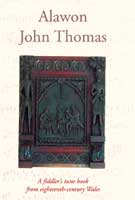 is also the editor of Alawon John Thomas, John Thomas's manuscript of
Welsh fiddle music from 1752.
is also the editor of Alawon John Thomas, John Thomas's manuscript of
Welsh fiddle music from 1752.
The vast majority of John Thomas's repertoire consists of dance tunes, most are
tunes associated with the country dance. Still played, the hornpipe "Flowers of Edinburgh"
"Jenny Dang The Weaver" (-> FW#24,
FW#26),
or the slip jig "Wife Of My Own" (-> FW#27).
The first strain of "Piss Upon the Grass" is still sung in the nursery rhyme
"Here We Go Round the Mulberry Bush" (-> FW#26).
The other main function of John Thomas's music seems to have been the accompaniment
of song, e.g. the popular Welsh air "Ay Hyd y Nos" (All Through the Night).
"Bili Bylero" is nothing else than "Lilliburlero", the famous anti-papist song of 1688
(-> FW#27). "Bryniau'r Werddon" (Hills of Ireland ->
FW#10) is an air that I learned in a
session a decade ago. Still popular among British balladeers:
"Maggie Lauder", "Bonnie Dundee", a London broadside taken up by the Scotch as
peculiarly their own, "Blackeyed Susan", and all "Cuckoo" and "Nightingale" birds
(see also -> FW#24).
There is composed instrumental music as well,
Henry Purcell, the 12th movement of
Handel's "Water Music",
and popular songs of the London theatres and the ballad operas.
"Bumper Squire Jones" is attributed to Turlough O'Carolan (->
FW#20).
The subject of the song was Thomas Morres Jones of Moneyglass House, Co. Antrim,
Northern Ireland. His family came to Ireland from Ystrad, Wales, in the time of
Charles II. The verses celebrate the Squire's hospitality:
Ye good fellows all who love to be told where there's claret good store,
be sure you don't pass the good house Moneyglass, for pray what would you more
than mirth with good claret and bumper Squire Jones.
According to O'Sullivan (-> FW#20),
Carolan and Baron [Arthur] Dawson happenend to be enjoying together the hospitalities of Squire
Jones at Moneyglass, and slept in rooms adjacent to each other. The bard, being called
upon by the company to compose a song or tune in honour of their host, undertook to
comply with their request and, on retiring to his apartment, took his harp with him,
and produced the melody now known as "Bumper Squire Jones". While the bard was thus
employed, however, the Judge [Dawson] was not idle. Being possessed of a fine musical
ear, as well as of considerable poetical talents, he not only fixed the melody on his
memory, but actually wrote the noble song now incorporated with it. At breakfast on the
following morning, when Carolan sung and played his composition, Baron Dawson, to the
astonishment of all present and of the bard in particular, stoutly denied the claim of
Carolan to the melody charged him with audacious piracy, and to prove the fact sung the
melody to his own words amidst thy joyous shouts of approbation of all his hearers - the
enraged bard excepted, who vented his execrations on the Judge in curses both loud and deep.
Another manuscript 200 years later, and there are no overlaps regarding the tunes -
well, save "O Shepherd, O Shepherd" which turns out being a modal version of "Greensleeves".
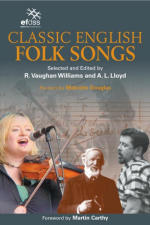 This is possibly because Classic English Folk Songs contains material that
has been published in "The Journal of the Folk Song Society" and its successor, "The
Journal of the English Folk Dance and Song Society", but the editors have confined
themselves to songs and variants unpublished outside the pages of the Journals.
According to the introduction of the 1959 edition.
This is possibly because Classic English Folk Songs contains material that
has been published in "The Journal of the Folk Song Society" and its successor, "The
Journal of the English Folk Dance and Song Society", but the editors have confined
themselves to songs and variants unpublished outside the pages of the Journals.
According to the introduction of the 1959 edition.
Meanwhile the British folk music revival swept the country and we are quite familiar
to a lot of songs, e.g.
"Death of Queen Jane" (once again recorded by Mark Evans, see CD review in this FW issue),
"Blacksmith" (-> FW#20,
FW#25),
"Geordie" (-> FW#21,
FW#23),
"Greenland Whale Fishery" (->
FW#20), and so forth.
"The Devil and the Ploughman": The Devil comes to fetch a farmer's wife. The farmer is
delighted. But the shrewish woman behaves so abominably in Hell that the Devil is
obliged to bring her back again. Perhaps in early forms, the farmer had enlisted the
Devil's aid with his ploughing, promising the soul of one of his famiy in return. Most
versions of this song have a whistled refrain, for there is an old belief that whistling
summons the Devil.
There was an old farmer in Sussex did dwell, (whistle...)
And he'd a bad wife as many knew well, to my fal-de-ral little law-day
So the devil he took the old wife on his back,
and lugged her along like a pedlar's pack.
He trudged along till he reached his front gate,
says: Here, take in an old Sussex chap's mate.
There was thirteen imps all dancing in chains,
she up with her pattens and beat out their brains.
Two more litle devils jumped over the wall,
saying: Turn her out, father, she'll murder us all.
So he bundled her up on is back amain,
and to her old husband he took her again.
I've been a tormentor the whole of my life,
but I was never tormented till I met your wife.
"The Gentleman Soldier", though recorded by the Pogues and
common in the army, has rarely found its way into he conventional song collections.
The poet John Clare knew it as a fiddle tune, "The Soldier's Cloak" (->
FW#24).
It's of a gentleman soldier, as a sentry he did stand,
He kindly saluted a fair maid by waving of his hand.
So boldly then he kissed her, and passed it as a joke.
He drilled her into the sentry-box, wrapped up in a soldier's cloak.
Now come, you gentleman soldier, and won't you marry me?
Oh no, my dearest Polly, such things can never be,
For maried I am already, and children I have three.
Two wives are allowed in the army, but one's too many for me!
First published in 1959 as "The Penguin Book of English Folk Songs" and edited by
Ralph Vaughan Williams (1872-1958) and
Albert Lloyd (1908-82),
this selection reclaimed traditional song from the school and the recital room,
and from the 'evening dress'.
Williams noted more than 800 songs from 1903 until 1913, and afterwards
he set numerous folk songs for schools and for choirs.
Lloyd published "The Singing Englisman" in 1944 as a radical
alternative to Sharp's "English Folksong" (->
FW#26), argueing that folk music,
appropriated by the middle classes, should be returned to the workers who had created it.
"Classic English Folk Songs" includes a new bibliography, supplementary notes, and a
foreword by Martin Carthy (-> FW#18,
the cover shows his daughter Eliza, I guess, ->
FW#4,
FW#26).
As always, tunes and songs are published so that people can play them again.
Now - did you know that the New York St Patrick's Day Parade was founded by the
British army? Pete McCarthy found out, looking for his clan in the US of A (might
be a relative of Senator Joe McCarthy or William McCarthy aka Billy the Kid):
The New York St Patrick's Day Parade has inspired many imitators all over the world,
not least in Ireland itself, where until the 1970s the saint's day was celebrated
by closing all the pubs so that a suitably pious and penitent mood might be observed.
The first New York parade was organised in 1766 by homesick expatriate Irishmen who
were serving as soldiers in the British army, doing their bit to keep the colonies in
their place. For years I've been hearing stories of New York's St Patrick's Day Parade, still the
biggest in the world. It's either a glorious celebration of Celtic pride and the
achievements of Irish America, or a shame-making Disneyfication of stomach-turning
paddy-whackery and drunken sentimentality, depending on whom you believe. I figured
it was time to find out for myself.
The minutes later I'm turning the corner onto Fifth Avenue, walking right up the middle
of the street, past the dignitaries' grandstand outside St Patrick's Cathedral, head
held high smiling and waving back to the politicians, the cardinals, the Kennedys,
Michael Flatley's parents, Seamus Heaney's
[-> FW#27]
second cousins, whoever the hell it is
sitting up there applauding us. We pass a roadside protest against the exclusion of
gay groups. A guy is holding a placard saying Another Queer from Ireland, which
would make a cracking album title.
There's a marching band ahead and a pipe band somewhere behind. There are no actual
Irish Irish people near me. Everyone is second, third or fourth generation And everyone
is sober, the city has banned street drinking at all parades.
England Get Out of Ireland, says the County Derry Association banner, which is
being carried by some polite-looking ladies in sensible coats. Close behind come the
self-proclaimed Irish Freedom Comittee. The bizarre combination of paramilitary chic
and yer granny's traditional hand-knit suggests bedroom revolutionaries whose mothers
tolerate the black gear, but won't let the out of the house unless they're dressed up
smart in that nice jumper they got for Christmas.
A mournful-looking Chinese man come walking down the stairs. He takes out one of those
curious Chinese string instruments that may be distantly related to the cello. He
launches into a tender,heartfeld and authentically oriental rendition of Danny Boy.
My last glimpse is of a band of African-American college kids dancing on the spot and
waving their trumpets and saxophones in the air as they play On Broadway. I don't
think the Drifters
were Irish, but I suppose you can never be sure.
McCarthy also paid a visit to Damn Demon's Land, aka Van Diemen's Land, aka
Tasmania. Australia is rarely featured in this magazine
(-> FW), and that's a pity.
Irish emigrants and their descendants in Australia are estimated as being 20-30 per
cent of the population.
Irish nationalists and criminals, often for crimes as trivial as
poaching or theft of a bread, were transported first to America and after the
American War of Independance to Australia.
The Turning Wave - Poems and Songs of Irish Australia is a gorgeous
 collection. Early Australian folk-song displays Irish-style features, the
best-known writer "Frank the Poet" may introduce himself:
collection. Early Australian folk-song displays Irish-style features, the
best-known writer "Frank the Poet" may introduce himself:
My name is Frank MacNamara, a native of Cashel, County Tipperary,
Sworn to be a tyrant's foe, and while I live I'll crow.
McNamara's most famous ballad is the convict's lament "Moreton Bay",
based on the "Youghal Harbour"/"Boolavogue" air. He also put to rhyme:
I was convicted by the laws of England's hostile crown,
Conveyed across those swelling seas in slavery's fetters bound.
For ever banished from that shore where love and friendship grow
That loss of freedom to deplore and work the labouring hoe.
Side by the side with poetry has been song, set to the standard list of Irish tunes,
many of them are rebel songs of the 1798 rebellion (-> FW#4),
"Wearing of the Green", "Boys of Wexford", "Men of the West".
The rebels of 1848 (Young Irelanders) were men and women of the pen rather than of the
sword, William Smith O'Brien and
Thomas Francis Meagher wrote during the passage rather ironically:
Although it is our lot to range the earth's wide surface o'er,
Yet still our hearts can know no change - we're Paddies evermore!
There is poetry about the Irish Famine, rarely found in Ireland itself.
Some is in Gaelic. "Na Connerys", a song still sung today.
remembers three brothers from Co. Waterford who were transported in the 1830s
for involvement in land agitation following eviction from their farm.
There is a series of narrative ballads of outlawry and bushranging, from
Bold Jack Donahue to Ned Kelly.
But there are poems of love, joy and humour too.
"Drover's Dream" is closely associated to 19th century stage-Oirishry:
One night when travelling sheep, my companions lay asleep,
There was not a star to illuminate the sky;
I was dreaming I supose, for my eyes were partly closed,
When a very strange procession passed me by.
The pelican and the crane, they flew in from off the plain,
To amuse the company with a Highland fling.
And the dear old bandicoot played a tune upon his flute,
Koalas all sat round him in a ring.
Three frogs from out the swamp, where the atmosphere is damp,
Came bounding in and sat upon a stone.
They each unfurled their swags, and produced from tiny bags
The violin, the banjo and the bones.
The goanna and the snake and the adder wide awake,
With the alligator danced "The Soldier's Joy".
'Neath the spreading silky oak the old jackass cracked a joke,
And the magpie sang "The Wild Colonial Boy".
Poets reflected the treatment of the Aboriginal people, while at the same time
anglicised Irish names supplanted Aboriginal names on the Australian landscape.
But they were also looking back to what was happening in Ireland, e.g. the hungerstrike
of Bobby Sands (-> FW#23), who wrote
"Back Home in Derry" while being jailed in Northern Ireland:
In 1803 we sailed out to sea, for Australia bound if we didn't all drown.
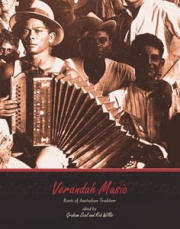 Andy Irvine
(-> FW#5,
FW#11,
FW#23),
who spents a few months of each year in Australia, wrote the union song "Gladiators".
Andy Irvine
(-> FW#5,
FW#11,
FW#23),
who spents a few months of each year in Australia, wrote the union song "Gladiators".
Irish traditional music evolved into Australian folk music: Here, in Australia,
with love and devotion, we'll weave a new song for our own native lyre.
The Irish may boast:
Who gave Australia the tunes to sing, the tunes of songs so grand,
Songs to inspire, full of beauty and fire? The answer's Ireland!
But the Irish were not the only nation, as the poet knows:
Green, Irish fields my people trod, and thine the English leas;
Our comrades sprang from Teuton stock, or Greek, or Genoese -
I care not whence our people came; but this all times I care:
The land that gave us birth and bread is ours - Australia fair.
The full spectrum is featured in Verandah Music - Roots of Australian Tradition.
First of all, what is verandah music?
The music made and played by those who have come to these shores, and those who were
long here, speaks of work, family, struggle, joy and sorrow. Verandah music springs
from the everyday lives of Australians; it is local music, usually played for intimate
gatherings of family, friends and colleagues, or for the community. One or two are
professional or semi-professional performers whose music has found a wider audience
through folk festivals, radio and recordings, but the music performed by these people
is not produced for commercial purposes - it evolves from the traditions of their
cultures, family or occupation. Verandah music is the kind of music often called
folk or roots. In verandah music can be heard the traditions of British
and European folksong and music, Aboriginal music-making, blues, hillbilly or
country musc, hula or island music, rock and roll, jazz, old-time and just about any
other form of music that has come to these shores. As the Australian tongue has reshaped
the English language, so our verandah musics have borrowed, adaptde and re-shaped the
songs and music that have appealed to them, to make them uniquely their - and our - own.
About 50 biographies are presented. We meet Dutch, Italian and native Aborginal
musicians, playing the gumleaf, the 14-string mandola and the Swedish nyckelharpa.
Val McGinness' life spanned most of the last century. The son of Lucy (Alyandabu), a
Kungkarukunj lady, and Stephen Joseph McGinness, an Irishman by birth but Scottish-raised,
Val inherited the genes of fighters and singers from both cultures. Val recalled
that his father could dance Scottish dances and he sang a lot of Scottish songs.
His mother sang Scottish songs too - never Aboriginal songs. She often joined Stephen
in raucous renditions of old ballads, while Stephen danced a wild highland fling. It
was very strange to hear my mother, a full-blood Aboriginal, singing Scottish songs.
The 1930s were the heyday of the Darwin string band era. Val finally took up the
mandolin. They played for countless dances and social events. Television and Cyclone
Tracy finally brought the days of old Darwin to a close.
Simon McDonald was born at Springmount, Victoria, in 1907. He began his life in a
three-roomed bush hut, made mostly of saplings and bark. Simon left school at fourteen,
chopping wood, cutting hay, milking cows, ploughing, and digging potatoes. In the
economic depression of the 1930s he hunted for gold and took up haircutting.
Simon senior and sons made music at home and at dances, where Simmie and his brother
John played tin whistles. Simon McDonald's repertoire far exceded fifty songs and
at least seven poems of his own composition. McDonald was part of a band formed late
in the Second World War to entertain American servicemen at local dances on R&R leave.
Simon did not seem to discriminate between the older and the newer popular songs,
except when pressed by people from folklore societies. Simon McDonald's everyday life
was documented in the lyrics of his poems and songs.
When he was sixty, Simon looked much older. He spent his days collecting worms and
picking blackberries (of which he had two kinds - those knocked down with a stick
or the more expensive hand-picked variety), and his nights cadging drinks in
return for a song.
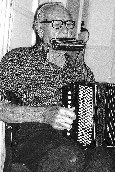
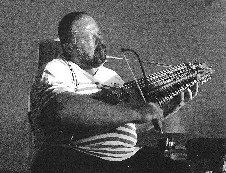
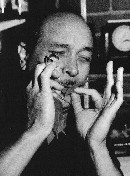
Les Schulz (Mezon Grand Organ);
Ulf Stenback (Nyckelharpa);
Virgil Reutens (Gumleaf).
With Jack Canny and his fiddle in attendance, there was a lift to the playing at
the Irish session at the Pot Belly in Canberra,
Jack was born at Glendree in County Clare in 1912. Music was a core part of the
Glendree community and Jack's father, Patrick Canny, was one of the most respected
fiddlers in the district, by reputation a strong player who knew hundreds of tunes.
Some of Pat's music found its way into "O'Neill's Music of Ireland". Jack's youngest
brother Paddy Canny
became a seminal figure in the Irish music scene. In 1956 he
recorded "All Ireland Champions" with flute player
Peader O'Loughlin [-> FW#24]
and his brother-in-law, PJ Hayes (father of the now more famous
Martin Hayes),
and founded the Tulla Ceili Band.
Jack moved to England at 23 years of age, looking
for work. He married and migrated to Australia in 1961. As the Irish music scene
blossomed in Australia, and sessions began to form regularly, Jack was there. He
formed an authentic link to the Irish music heartland of the past.
Verandah Music includes lots of pictures and two CDs, where I found the witty
Spanish song "La Rana Cantanda" (The Singing Frog), translated as:
The frog was singing and the fly came and made her stop.
The fly was singing and the spider came and made her stop.
The spider was singing and the mouse came and made her stop.
The mouse was singing and the cat came and made her stop.
The cat was singing and the dog came and made her stop.
The dog was singing and the man came and made her stop.
The man was singing and the mother-in-law came -
And no one, not even the devil, could make her stop singing!
A website has been established with further information,
www.verandahmusic.com,
and its editors state:
More than everything, we have sought to show that the music documented here is not
archaic. The compact discs accompanying this book include examples of younger people
performing new versions of traditional songs and tunes. The willingness of these
performers to adapt traitional material show that verandah music is not restricted
to archives and museums. It is living, changing music that is meaningful - often
profoundly - to the lives of those who make it and those who hear it.
That's what we always say. Keep going, T:-)M.
Burke, Colleen Z. and Vincent Woods (ed). The Turning Wave - Poems and Songs
of Irish Australia. Kardoorair,
Armidale, NSW, 2001, ISBN 0-908244-47-9, Paperback, 304pp.
Hickey, Donal. Stone Mad for Music - The Sliabh Luachra Story.
Marino, Dublin, 1999, ISBN 1-86023-097-0, Paperback, 223pp, €10.15.
McCarthy, Pete. The Road to McCarthy.
Hodder & Stoughton, London, 2003, ISBN 1-340-76607-7, Paperback, 463pp.
Meurig, Cass (ed.). Alawon John Thomas - A Fiddler's Tune Book from Eighteenth-Century Wales.
National Library of Wales, Aberystwyth, 2004, ISBN 1-86225-042-1, Paperback, 180pp, UKŁ13.99.
Ó Canainn, Tomás. Seán Ó Riada - His Life and Work.
Collins, Cork, 2003, ISBN 1-903464-40-4, Paperback, 214pp, €17.95.
O'Hea O'Keeffe, Jane. The Ancient Barony of Duhallow - Living Voices.
Irish Life and Lore Series, Tralee, 2003, ISBN 0-9543274-1, Paperback, 78pp, €9,99.
Seal, Graham and Rob Willis (ed). Verandah Music - Roots of Australian Tradition.
Curtin University Press, Fremantle, 2003, ISBN 1-920731-97-0, Paperback, 160pp, AUS$49.95 (incl. 2 CDs).
Vaughan Williams, R. and A.L. Lloyd (ed). Classic English Folk Songs.
English Folk Dance & Song Society, London, 2003, ISBN 0-85418-188-1, Paperback, 154pp, UKŁ14.99.
More...
Celtic:
FW#19,
FW#20,
FW#24,
FW#27
Song & Tune-Books:
FW#21,
FW#22,
FW#24,
FW#26
German Titles
Back to the content of FolkWorld Features
To the content of FolkWorld No. 28
© The Mollis - Editors
of FolkWorld; Published 04/2004
All material published in FolkWorld is © The
Author via FolkWorld. Storage for private use is allowed and welcome. Reviews
and extracts of up to 200 words may be freely quoted and reproduced, if source
and author are acknowledged. For any other reproduction please ask the Editors
for permission. Although any external links from FolkWorld are chosen with greatest
care, FolkWorld and its editors do not take any responsibility for the content
of the linked external websites.
FolkWorld - Home of European Music

Layout & Idea of FolkWorld © The
Mollis - Editors of FolkWorld
 recordings in selected areas. To come are West Limerick, Kerry, Clare and Galway,
45 CDs cover the area of the ancient barony of Duhallow
which straddles along the Cork/Kerry border.
The area includes the sites of the Battle of Knockbrack in 1651 and
Knocknanuss in 1647 during the Cromwellian Wars;
the Scottish warrior Alistair McDonald was killed during the latter,
commemorated in "Allistrum's March" (->
FW#24).
In the west of Duhallow lies Sliabh Luachra with its unique tradition of music and poetry.
recordings in selected areas. To come are West Limerick, Kerry, Clare and Galway,
45 CDs cover the area of the ancient barony of Duhallow
which straddles along the Cork/Kerry border.
The area includes the sites of the Battle of Knockbrack in 1651 and
Knocknanuss in 1647 during the Cromwellian Wars;
the Scottish warrior Alistair McDonald was killed during the latter,
commemorated in "Allistrum's March" (->
FW#24).
In the west of Duhallow lies Sliabh Luachra with its unique tradition of music and poetry.



 is also the editor of Alawon John Thomas, John Thomas's manuscript of
Welsh fiddle music from 1752.
is also the editor of Alawon John Thomas, John Thomas's manuscript of
Welsh fiddle music from 1752.
 This is possibly because Classic English Folk Songs contains material that
has been published in "The Journal of the Folk Song Society" and its successor, "The
Journal of the English Folk Dance and Song Society", but the editors have confined
themselves to songs and variants unpublished outside the pages of the Journals.
According to the introduction of the 1959 edition.
This is possibly because Classic English Folk Songs contains material that
has been published in "The Journal of the Folk Song Society" and its successor, "The
Journal of the English Folk Dance and Song Society", but the editors have confined
themselves to songs and variants unpublished outside the pages of the Journals.
According to the introduction of the 1959 edition.
 collection. Early Australian folk-song displays Irish-style features, the
best-known writer "Frank the Poet" may introduce himself:
collection. Early Australian folk-song displays Irish-style features, the
best-known writer "Frank the Poet" may introduce himself:
 Andy Irvine
(-> FW#5,
FW#11,
FW#23),
who spents a few months of each year in Australia, wrote the union song "Gladiators".
Andy Irvine
(-> FW#5,
FW#11,
FW#23),
who spents a few months of each year in Australia, wrote the union song "Gladiators".



